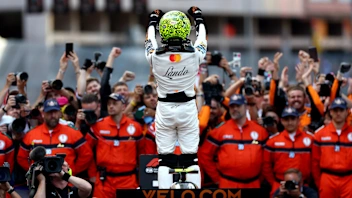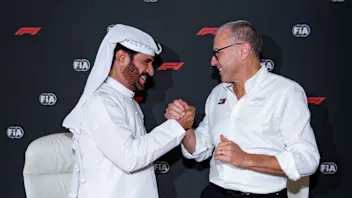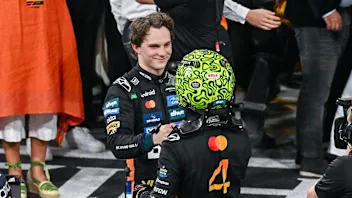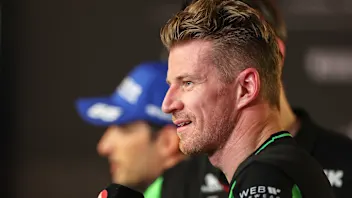Sebastian Vettel Q&A: At least I know the seat fits!
The opening test day of 2014 did not go to plan for Sebastian Vettel and Red Bull, as an unexpected technical glitch kept him in the Jerez garage until the final 15 minutes of the session. Coming to any conclusions about the new RB10 after just three laps is obviously a tough ask, but one thing Vettel was sure of is that racing is going to be very different this season…
Q: Seb, weren’t you supposed to be in the car all day today?
Sebastian Vettel: Actually yes, that was the plan, so as you can assume it was not the ideal first test day. We had some issue overnight - we assembled one piece wrong and it took some time to get to that part and change its position. A minor mistake like that can happen considering the thousands of parts that a car consists of. And considering that so many parts are new, the engineers wanted to go through the procedure step by step to make sure that it does not happen again.
Q: So the question of where you see the biggest changes over the old cars is rather rhetorical after only completing three laps…
SV: Don’t underestimate me, I do have my clues! (laughs) With the new power unit we do expect significantly more engine torque compared to last season, as we will have less revs. So this will have consequences for the driving. Of course, the sound is very different too. It is not so loud anymore in the cockpit. (laughs) From the aero side there will be less grip, as ‘our wings got clipped’, which means less speed - and in this respect this definitely is a regression to the old cars. What will also have a huge significance will be the tyres - again. But it is hard right now to say what the reality will be. The only thing that I can positively say is that the seat fits!
Q: You’ve no doubt done a lot of simulator work, but how valuable is that when you actually get in a brand new car with no other references?
SV: It is valuable, although no doubt it is very different to the situation at this moment. In the simulator it is pretty much business as usual, whereas in the car your main focus right now is to see that everything is functioning. So from this respect - to see that the car does the job - nothing compares to driving. Believe me, not driving more today is a maximum penalty. But let’s not forget, whatever Red Bull’s engineers came up with in the last few years worked both in the simulator and on the track, so I am optimistic that what I have experienced in the simulator can also be translated to the track.
Q: Regarding your minimal running, could that mean the team might decide to give you more running time and less to your team mate Daniel Ricciardo?
SV: That is not the plan right now, but let’s see how it is working tomorrow. I don’t think I’m revealing a secret when I say that it was pretty quiet today. It was not only us that was doing only a few laps - there where others that were not running at all. I think pretty much everybody has had his share of being caught up with too many innovations. But that will not last. The moment routine sets in again - meaning that you know all the ins and outs of the new car and you can react accordingly - then we are pretty much where we left off racing in Brazil.
Q: Pretty much where you left off racing in Brazil… does that mean that you don’t have to change your driving style?
SV: No it does not mean that. If you drive like last year you won’t see the chequered flag. That much is fact. Racing will change. Full throttle looks like a thing of the past. How different it will really be you can ask me again after the first race in Australia. Then we should all have a realistic view on the do’s and don’ts of driving under race conditions.
Q: How aware are you of what is happening technically in your car?
SV: I know that it is a very complex system - and that is rightly so, as it costs a lot of money and time. Before F1 cars were not so close to rocket science like they are now. The question will be if everyone can make that step. It is fascinating technology and let’s see if F1 is the right platform. As for myself, I have a pretty good idea of what is going on a general level, but as for going into details, no, I am not that far right now. I have an A-level-exam and I’ve done some years of motorsport so I know a bit, but when even the engineers right now find it hard to really understand what is going on within that system, then I should be excused.
Q: Will races be more strategic - and will the interaction between cockpit and pit wall intensify?
SV: Yes, the interaction between driver and pit wall will become more crucial than ever in the past. You have 100 kilos of fuel, period. So it will be up to the pit wall to decide when to go fast and when to save. Strategy will pretty much be the name of the game.
Q: There are predictions that we will see a massive amount of DNF’s at every race. Is that also what you expect?
SV: Did I ever pretend to be able to look into the future? (laughs) What I can say is that right now the learning curve is pretty steep. Every day we work with the car we know so much more about it than the day before - and it will be a question of whether everybody on the grid manages that curve. Right now I would bet my money on consistency rather than on speed. But, as I said, that’s right now.
Q: Double points at the final round of the season. What’s your view on that?
SV: In my opinion that is nonsense. I don’t understand why one race should be more ‘valuable’ than another. It would be like in football if they changed the rules by saying that a goal scored in the last five minutes counted double. Nobody would think of something bizarre like that.
Next Up
Related Articles
 Sainz hopes point-less finish in Abu Dhabi ‘serves as a wake-up call’
Sainz hopes point-less finish in Abu Dhabi ‘serves as a wake-up call’ PalmerThe 6 defining moments of Norris’ title-winning season
PalmerThe 6 defining moments of Norris’ title-winning season F1, the FIA and 11 teams sign 2026 Concorde Agreement
F1, the FIA and 11 teams sign 2026 Concorde Agreement Piastri 'will be a world champion' in future – Norris
Piastri 'will be a world champion' in future – Norris/Untitled-10.webp) Bottas embarks on first day as a Cadillac driver
Bottas embarks on first day as a Cadillac driver Hulkenberg pleased to score points in Sauber’s final race
Hulkenberg pleased to score points in Sauber’s final race